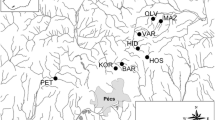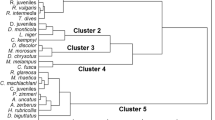Abstract
Cumulatively scored distributions of the slipper shell gastropodCrepidula sp., the sand-building polychaete wormSabellaria vulgaris, the calcareous meandering tubed polychaeteFilograna implexa, the barnacleSemibalanaus balanoides, and the lacy bryozoanSchizoporella sp. were mapped on a cm-square gridded silhouette of the prosoma, opisthosoma, and movable spines, and telson of the horseshoe crabLimulus polyphemus stranded on Reeds Beach, Cape May County, New Jersey in the Delaware Bay. Statistically tested and contoured epizoan frequencies for 81 males and 59 females revealed that slipper shells and agglutinated worm tubes are concentrated near the movable spines on the opisthosoma, but rare on recessed chilarial or opercular pleurites, the prosoma, and telson. Barnacles are disproportionately concentrated in entapophyseal pits on the opisthosoma and in the longitudinal furrows flanking the cardiac lobe of the prosoma. Bryozoans are concentrated near movable marginal spines of the opisthosoma, but also found on all areas of the prosoma, opisthosoma, and hinge area in between, as well as the telson. Different morphologic sites for their respective modal concentrations may result from competitive exclusion of bryozoans by barnacles. Genal angles have lower statistically predicted frequencies of bryozoans, barnacles, and sand worm tubes. Apertural openings of calcareous tubes are predominantly posteriorly oriented whereas the anterior magin of slipper shells are randomly oriented on the opisthosoma. Eschewing differential mortality, nonrandom distributions indicate possible: rugophilic (groove-seeking) larval settlement behavior for barnacles that preferred the recessed hinge area, longitudinal grooves, and pits; rheophilic (current-seeking) larval settlement behavior for the gastropods and tube-building polychaetes that filter feed in the eddies generated near the movable spines of the downcurrent-sloping opisthosoma; and geotactic (gravity-influenced) larval settlement or post-settlement migration to the vaulted crest (cardiac lobe). Deficiencies of protruding epizoic skeletons on the genal angles and anterior margin of the host may be due to removal by abrasion as the horseshoe crab plowed through sediment or shearing of the epizoans from the carapace substratum in strong currents or waves.
Similar content being viewed by others
Literature Cited
Babcock, L. 1993. Trilobite malformations and the fossil record of behavioral asymmetry.Journal of Paleontology 67:217–229.
Baker, P. 1997. Settlement site selection by oyster larvae,Crassostrea virginica: Evidence of geotaxis.Journal of Sheldfish Research 16:125–128.
Barber, S. D. 1956. Chemoreception and proprioreception inLimulus.Journal of Experimental Zoology 131:51–69.
Becker, K. 1996. Epibionts on the carapaces of some malacrustaceans from the Gulf of Thailand.Journal of Crustacean Biology 16:92–104.
Bien, W., J. Wendt, andR. Alexander. 1999. Site selection and behavior of sponge and bivalve borers in shells of the Cretaceous oystersExogyra cancellata andPycnodonte mutabilis from Delaware, USA.Historical Biology 13:299–315.
Bottjer, D. 1982. Paleoecology of epizoans and borings on some Upper Cretaceous chalk oysters from the Gulf Coast.Lethaia 15:75–84.
Botton, M. 1984. Diet and food preference of the adult horseshoe crabLimulus polyphemus in Delaware Bay.Marine Biology 81:199–207.
Botton, M. L. andJ. W. Ropes. 1988. An indirect method for estimating longevity of the horseshoe crab (Limulus polyphemus) based on epifaunal slipper shells (Crepidula fornicata).Journal of Shellfish Research 7:407–412.
Butman, C. A. andJ. P. Grassle. 1992. Active habitat selection byCapitella sp. 1. Larvae I. Two-choice experiments in still water and flume flows.Journal of Marine Research 50:669–715.
Cadee, G. C. 1991. Carapaces of the shore crabCarcinas meanus as a substrate for encrusting organisms, p. 71–79.In F. P. Bigley (ed.), Bryozoans Actuels et Fossiles. Bulletin Societe Scientifique Naturale Ouest France. Memoir HS 1, Nantes, France.
Chabot, R. andE. Bourget. 1988. Influence of substratum heterogeneity and settled barnacle density on the settlement of cyprid larvae.Marine Biology 97:45–56.
Chapple, W. D. 1977. Role of asymmetry in functioning of invertebrate nervous system, p. 3–22.In S. Harnad, R. W. Doty, L. Goldstein, J. Jaynes, and G. Krauthamer (eds.), Lateralization in the Nervous System. Academic Press, New York.
Cragg, S. M. andL. D. Gruffyd. 1975. The swimming behavior and pressure response of the veliconcha larvae ofOstrea edulis L., p. 43–57.In H. Barnes (ed.), Proceedings of the Ninth European Marine Biology Symposium, Aberdeen University Press, Aberdeen, Scotland.
Cragg, S. M. andJ. A. Nott. 1977. The ultrastructure of the statocysts in the pediveliger larvae ofPectin maximus (L) (Bivalvia).Journal of Experimental Marine Biology and Ecology 27:23–36.
Cranfield, H. J. 1973. Observations on the behaviour of the pediveliger ofOstrea edulis during attachment and cementing.Marine Biology 22:203–209.
Crisp, D. J. andH. Barnes. 1954. The orientation and distribution of barnacles at settlement, with particular reference to surface contour.Journal of Animal Ecology 23:142–162.
Crisp, D. J. andH. G. Stubbings. 1957. The orientation of barnacles to water currents.Journal of Animal Ecology 26:174–196.
Denny, M. W. 1988. Biology and the Mechanics of the Waveswept Environment. Princeton University Press. Princeton, New Jersey.
Denny, M. W. 1995. Survival in the surf zone.American Scientist 83:166–173.
Dick, M. H., W. E. Donaldson, andI. W. Vining. 1998. Epibionts of the Tanner crabChionoecetes bairdi in the region of Kodiak Island, Alaska.Journal of Crustacean Biology 18:519–528.
Eble, A. F. andR. Scro. 1996. General anatomy, p. 19–73.In V. S. Kennedy, R. I. E. Newell, and A. F. Able (eds.), The Eastern Oyster,Crassostrea virginica. Maryland Sea Grant, College Park, Maryland.
Eckman, J. E. 1990. A model of passive settlement by planktonic larvae onto bottoms of differing roughness.Limnology and Oceanography 35:887–901.
Forbes, L. M., J. B. Seward, andD. J. Crisp. 1971. Orientation to light and the shading response in barnacles, p. 539–558.In D. J. Crisp (ed.), Fourth European Marine Biology Symposium. Cambridge University Press, Cambridge, England.
Frazier, J. G., J. E. Winston, andC. A. Ruckdeschel. 1992. Epizoan communities on Marine turtles: III. Bryozoa.Bulletin of Marine Science 51:1–8.
Grassle, J. P., C. A. Butman, andS. W. Mills. 1992b. Active habitat selection by theCapitella sp. 1 larvae. II. Multiple choice experiments in still water and flume flows.Journal of Marine Research 50:717–743.
Grassle, J. P., V. R. Snelgrove, andC. A. Butman. 1992a. Larval habitat choice in still water and flume flows by the opportunistic bivalveMulina lateralis.Netherlands Journal of Sea Research 30:33–44.
Havanhand, J. N. andI. Svane. 1991. Roles of hydrodynamic and larval behaviour in determining spatial aggregation in the tunicateCiona intenstinalis.Marine Ecological Progress Series 68:271–276.
Kessling, R. V., R. D. Hoare, andD. K. Sparks. 1980. Epizoans of the Middle Devonian brachiopodParaspirifer bownockeri; Their relationship to one another and to their host.Journal of Paleontology 54:1141–1154.
Key, M. M., W. B. Jeffries, H. K. Voris, andC. M. Yang. 1996. Epizoic bryozoans, horseshoe crabs, and other mobile benthic substrates.Bulletin of Marine Science 58:368–384.
Key, M. M., J. W. Volpe, W. B. Jeferies, andH. K. Voris. 1997. Barnacle fouling of the blue crabCallinectes sapidus at Beaufort, NC.Journal of Crustacean Biology 17:424–439.
LeTourneaux, F. andE. Bourget. 1988. Importance of physical and biological settlement cues used at different spatial scales by the larvae ofSemibalanus balanoides.Marine Biology 97:57–66.
Levinton, J. S. 1998. Marine Biology. Oxford University Press, Cary, North Carolina.
Miller, S. L. 1974. Adaptive design and locomotion and foot form in prosobranch gastropods.Journal of Experimental Marine Biology and Ecology 14:99–156.
Mullineaux, L. S. andE. D. Garland. 1993. Larval recruitment in response to manipulated field flows.Marine Biology 116: 667–683.
Pawlik, J. R., C. A. Butman, andV. R. Starczak. 1991. Hydrodynamic facilitation of gregarious settlement of a reef-building tube worm.Science 251:421–424.
Pires, A. andR. M. Woollacott. 1983. A direct and active influence of gravity on the behavior of a marine invertebrate larvae.Science 220:731–732.
Quinn, E., K. Paradise, andJ. Atema. 1998. JuvenileLimulus polyphenus generate water currents that contact one proven and one putative chemoreceptor organ.Biological Bulletin 195: 185–187.
Ross, A. andC. G. Jackson, Jr. 1972. Barnacle fouling of the ornate diamond back terrapinMalaclemys macrosopilota.Crustaceana 22:203–205.
Snelgrove, P. V. R., C. A. Butman, andJ. P. Grassle. 1993. Hydrodynamic enhancement of larval settlement in the bivalveMulina lateralis (Say) and the polychaeteCapitella sp. 1: In microdepositional environments.Journal of Experimental Marine Biology and Ecology 168:71–109.
Walters, L. J. 1992. Field settlement locations on subtidal marine hard substrata. Is active larval exploration involved?Limnology and Oceanography 37:1101–1107.
Wethey, D. S. 1986. Ranking of settlement cues by barnacle larvae: Influence of surface contour.Bulletin of Marine Science 39:393–400.
Wildish, D. andD. Kristmanson. 1997. Benthic Suspension Feeders and Flow. Cambridge University Press, New York.
Wiseberg, M. J. andR. K. Zimmer-Faust. 1993. Life and death in moving fluids: Hydrodynamic effects on chemosensory-mediated predation.Ecology 74:1428–1443.
Wisely, B. 1969. Preferential settlement in concavities (rugophilic behavior) by larvae of the brachiopodWaltonia inconspicua (Sowerby 1846).New Zealand Journal of Marine and Freshwater Research 3:273–280.
Wise, G. A. 1971. Receptor organization and function inLimulus chelae.Zeitschrift vergleichende Physiologie 73:249–273.
Young, C. M. 1995. Behavior and locomotion during dispersal phase of larval life, p. 249–278.In L. McEdward (ed.), Marine Invertebrate Larvae. CRC Press, New York.
Zar, J. 1999. Biostatistical Analysis, 4th edition. Prentice Hall, New Jersey.
Zimmer-Faust, R. K., C. R. Finelli, N. D. Pentcheff, andD. S. Whetley. 1995. Odor plumes and animal navigation in turbulent water flow. A field study.Biological Bulletin 188:11–116.
Author information
Authors and Affiliations
Corresponding author
Rights and permissions
About this article
Cite this article
Dietl, J., Nascimento, C. & Alexander, R. Influence of ambient flow around the horseshoe crabLimulus polyphemus on the distribution and orientation of selected epizoans. Estuaries 23, 509–520 (2000). https://doi.org/10.2307/1353142
Received:
Accepted:
Issue Date:
DOI: https://doi.org/10.2307/1353142




